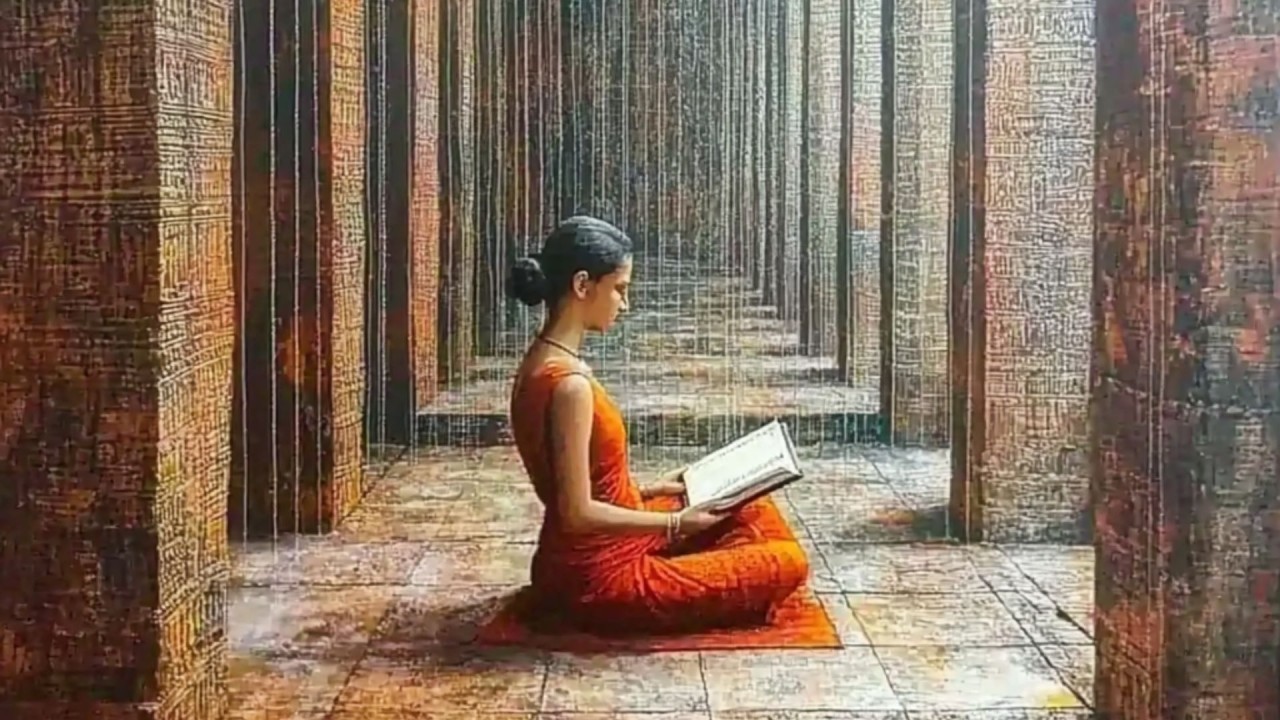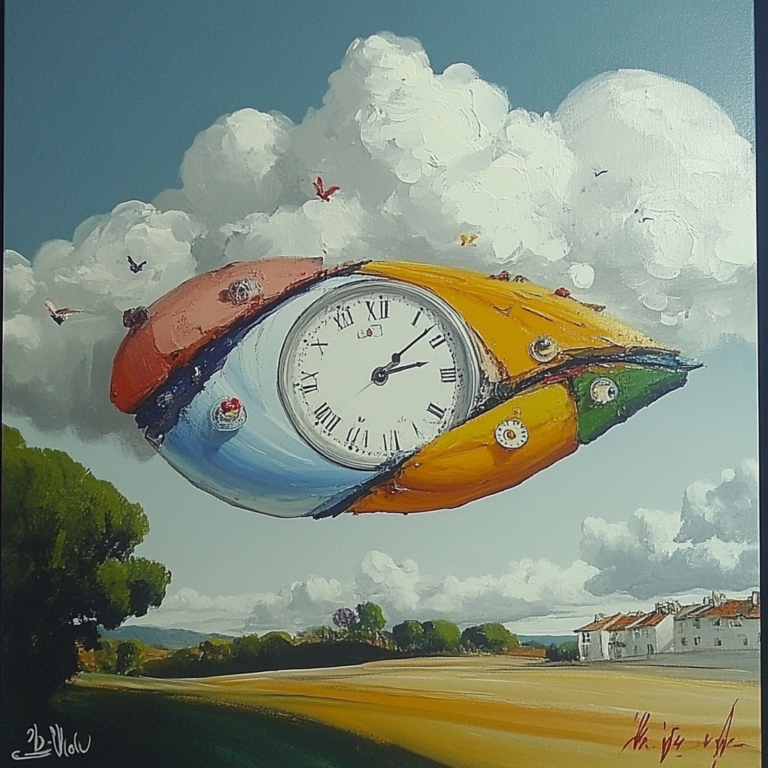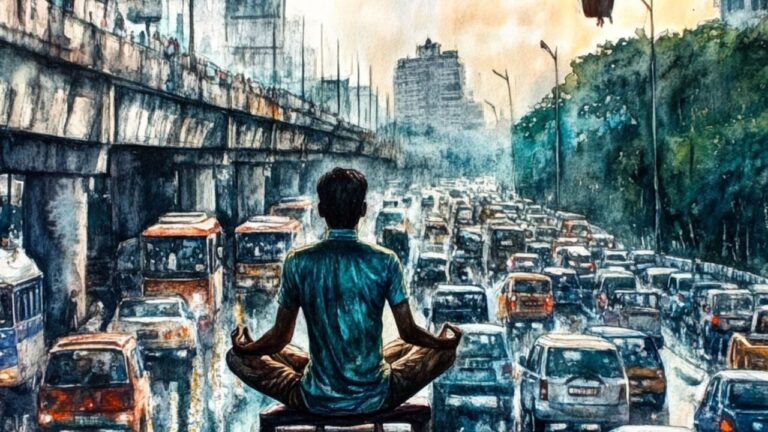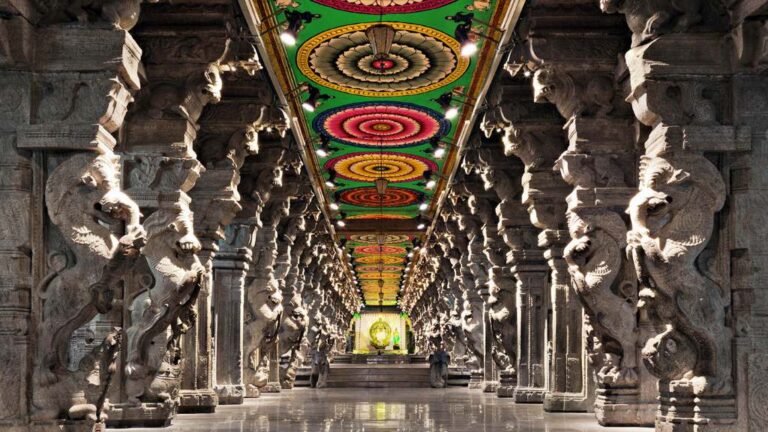Can you acquire “Jnana” by merely “reading” a text?
The idea that one can obtain jnana through reading is a Modern concept. In the Indian tradition “jnana” refers to the knowledge of the self, the invisible reality, the nitya and the knowledge of the world and material objects and phenomena is Vijnana.
In any case, ten people reading the same text can come to ten different conclusions or at least there will some variation from person to person.
Let us try to decode the process of reading.
(1) First, you have the reader. The person who is reading. He or she is made up of the panchabhootas which have come together uniquely to create this person. And so on for every person for every person is different.
The reader maybe energetically situated at the muladdhara chakra level, swadhisthana level, Anahata level etc. He or she may be Annamaya dominant. This person may have a higher proportion of Rajas than the other gunas (Sattva and Tamas). He may have a chanchala buddhi. He may have a very pronounced feeling of separateness from other people or groups of people. The point is there are enough factors to cause variation between people. He may have different levels of the Panchakleshas (avidya, asmita, raga, dwesha and Abhinivesha) and maybe suffering from the onslaught of the shadripus (kama, krodha, lobha, moha, mada, matsarya and Alasya). All these plus his upbringing, his environment, education and exposure all add to create a really unique individual. And you see the world the way you are not the way the world really is (which you cannot know anyway as long as you have negative samskaras and vasanas). Every individual has his own concepts of what is possible and what is not, what is real and what is false, what causes what etc – in other words, his own unique mental model through which he sees the world and reaches conclusions. Also, the same reader can have different moods, different states of mind and a different level of consciousness. So, one day one he is reader 1, on day two he is reader 2 and so on even though it is the same person. Further, each reader would have his unique language mix. He may know/read/speak one, two, three or more languages. Further, he has his own unique understanding of the meanings of different words in different languages. Add to all this the reader’s own life experiences, traumas, triumphs and tragedies that would have contributed significantly to his world view.
(2) Then you have the writer who again is a unique individual and all the above applies to the writer as well. In fact, the writer is using the medium of writing to express his world view and describe his own mental models. But many writers do say that they connected with their subconscious mind to write. It is very likely that he is at a different level of consciousness than the reader. It is quite possible. He has own unique set of life experiences which again would have shaped his worldview. There might be certain events happening in the world, particular situations that provided the context for what he has written. So again, there are many factors to be considered when trying to understand what the writer has written.
(3) Then you have the writing. What is the language in which it has been written? Is the book an original text or a translation. What is the original language and what is the language into which it has been translated? What is the style in which it has been written? In what sense have the words been used? But who made all these choices? The writer of course.
So, you can say, reading is essentially a process through which the reader and the writer are communicating with each other across time and space. One of the things we learn in a general communication course is that communication is impossible! And this could be because of so many reasons including the factors mentioned above. So, Language Barriers, Emotional Barriers, Cognitive Differences, Contextual Differences, Technological Issues, Lack of Willingness, Mistrust can prevent perfect communication from happening.
It is said, words or text (7%), tone of voice (38%) and body language (55%) are the elements of communication, and the receiver always receives the dominant communication. Assuming these percentages are true, you can see that the written text is missing the tone of voice and the body language of the communicator who is the author. In this case the reader will compensate for that by “hearing” a certain tone of voice in his mind and will assume a certain body language for the author (in his mind’s eye). And so, as many books as there are readers of a particular book.
Thus, each reader will make his own interpretations of the writing and reach his own conclusions. We can also think of texts as having gunas – they could be Sattvik, Rajasic of Tamasic. There would be a mismatch of energy frequencies between a tamasic person and a Sattvik text.
Now, our shrutis (Vedas & Upanishads) were composed by Rishis who were mantra drishtaras who directly perceived reality as it is being at the highest level of consciousness. What kind of communication would be possible between a lay reader and these great Rishis through the act of “reading” the Vedic texts? That too their English translations.
To attain Jnana means to transcend the intellectual understanding of the Vedas and instead internalize their teachings through lived experience, meditation, and direct spiritual practice. Further, the essence of the Vedas does not lie in merely word meanings. Vedas are also Shabda. This aligns with the traditional method of imparting Vedic knowledge through oral transmission and experiential learning, rather than the mere “reading” of texts. Traditionally, Vedic learning was an oral tradition, passed down from teacher (guru) to disciple (shishya) through a process of disciplined learning.
In the traditional Indian context, simply reading the Vedas without proper initiation, understanding of Sanskrit nuances, and without the guidance of a guru is insufficient to attain Jnana. This is because Vedic wisdom is embedded in multiple layers of symbolic, allegorical, and esoteric meanings, which require an experiential process of realization. What if these Shabdic wisdom texts were not meant to merely pass on knowledge embedded in words but to actually unlock the knowledge hidden in your own Chitta. What if it was not about the meaning of words but the effect of the words, the mantras on your consciousness? At every level of consciousness an individual sees a different reality of the universe. As consciousness rises, he sees more clearly. What if the Vedas were meant to raise your consciousness through the vibrations produced by the vedic mantras?
The Modern academic approach, which emphasizes reading and textual analysis, brought about a significant shift in how knowledge is approached in Bharata. Modern scholars who first encountered the Vedas approached these sacred texts much like they would any other historical or religious document. They translated, analyzed, and cataloged the texts as if the Vedas were merely repositories of information that could be understood by reading them as one would read a book.
This focus on the text—the idea that one could “obtain” Vedic knowledge by simply reading translations—led to the notion that Vedic wisdom is something that can be intellectually grasped. While this approach opened the Vedic texts to a broader audience, it also stripped them of their spiritual depth and the traditional framework required for their comprehension. The idea that the “naked eye” can grasp the essence of the Vedas without proper initiation, experiential learning, and a lived connection to the teachings is a Modern interpretation imposed upon an Eastern, oral, and experiential tradition.
Further, if suppose between the Reader A and the Writer B, there is a third person G who has achieved the same level of consciousness as the writer B. Could he then connect with the consciousness of the writer B and then help reader A understand the text? Yes, of course. And he is the one we call a Guru. G for Guru!
There is a saying, “Guru Bina Gati Na Hot” – without a Guru there can be no progress, no liberation. True knowledge is knowledge of the self. Atma jnana. It is not possible to attain it without the help of a Guru. And, as Sri Krishna stated in the Bhagawad Gita, “Jnani ko moksha, ajnani ko moksha nahi.” And who is the Jnani – the one who has known himself and through that the entire manifest universe, the entire creation. For acquiring Vijnana also, a truly qualified guru can make the biggest difference.
And therefore, the grace of a living siddha guru is considered absolutely essentially for moksha. The guru comes to awaken the Upaguru who is inside you. He helps to remove the cover of dark ignorance that has engulfed your mind and helps you see the eternal reality – helps you experience Sat-Chit-Ananda!
From the Guru Stotram:
अज्ञान-तिमिरान्धस्य ज्ञानाञ्जन-शलाकया।
चक्षुरुन्मीलितं येन तस्मै श्री गुरवे नमः ॥२॥
ajñāna-timirāndhasya jñānāñjana-śalākayā.
cakṣurunmīlitaṃ yena tasmai śrī gurave namaḥ ..2..
Salutations are to that guru who opened the eye of one blind due to the darkness (cover) of ignorance with a needle coated with the ointment of knowledge.






